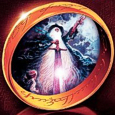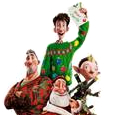United Artists/Fantasy Films (1978), Warner Home Video (April 6 2010), single disc Blu-ray plus DVD, 113 mins plus supplements, 1080p high-definition 1.85:1 widescreen, Dolby True-HD 5.1, Rated PG, Retail: $29.99
Storyboard:
Extraordinary wizard Gandalf instructs a young Hobbit, Frodo, to return the One Ring of the Dark Lord Sauron, to the fires of Mordor’s Mount Doom, where its sinister power can be destroyed forever. Along the way he is joined by a band of friends and foes, not least the formidable Hobbit-turned wretched creature Gollum, who wants the precious Ring for himself…
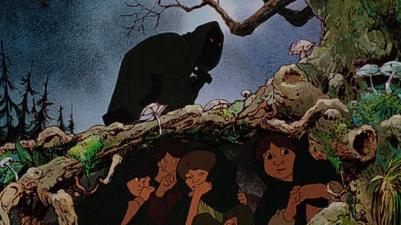
The Sweatbox Review:
In the late 1970s, a young Peter Jackson took his seat at his favorite movie palace in New Zealand, and found himself so disappointed at the event picture he saw unfolding on screen that he vowed to remake the film when he became a world class director. The film was, of course, the 1976 version of King Kong, which Jackson would go on to attempt to remake, as a more faithful to the original 1933 film, in 1998, and finally realize his dream onscreen in 2005. But there was another film, released around the same time, which must have also had an effect on the young director to be…
Jackson insists that Ralph Bakshi’s 1978 feature animation take on Tolkien wasn’t a big influence, but it’s clear when reviewing the film again that he must have been affected, even subconsciously, by several scenes and, in particular, specific shots and performances, when he came to create the celebrated live-action The Lord Of The Rings trilogy in 2001-2003. In fact, Jackson seems pretty content to let Bakshi’s film be treated to more of the rotten reputation it has amassed over the years: a reputation that has spread to the net, and an infamous and fantastically frustrated analysis of the movie that picks it apart scene by scene, shot by shot, even down to individual lines of dialogue.

It’s true that the film isn’t perfect, and it has to be said that the internet rant against the film has some pretty valid points to raise. But, as a slice of pure entertainment and an ambitious attempt to put a vastly complicated book onto the screen – and in animation no less – The Lord Of The Rings, 1978 style, is well worth another look, especially in this beautifully restored edition on Blu-ray, the likes of which we would probably have never seen had it not been for this Deluxe Edition riding on the coat tails of Jackson’s trilogy. Tolkien’s phenomenally successful book had almost made it to the screen before, in the 1960s, with The Beatles in the frame to portray the central group of the four Hobbits, so we must at least be thankful that director John Boorman wasn’t able to pull that project together.
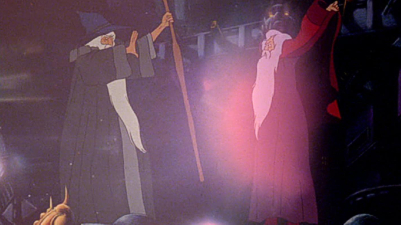
Instead, the rights fell to independent animator Bakshi, the so-called “bad boy of animation” who, for some reason in the early 1970s, being heralded as the “new Walt Disney”. His adult animation film Fritz The Cat had taken the crudity of disturbed comic book artist Robert Crumb and breathed cartoon life into the story. The film must have felt “fun” and “new” after decades of cute Disney creations, due to the plentiful offerings of sex and violence all carried out by typically drawn animated animals, and was a big hit based on its modest budget. There was a sequel, which Bakshi wasn’t involved with and was even less palatable than the first, while the director himself took to producing “personal” films that tried to convey his life’s influences and experiences.
His early 1950s and 60s career was full of interesting choices and promise: stints on such comic book cartoons as Deputy Dawg, The Mighty Heroes, Sub-Mariner, The Mighty Thor, Hulk, Captain America and, most memorably, the classic 1960s animated Spider-Man honed his abilities, though after Fritz The Cat, he concentrated exclusively on his own kind of provocative features. Heavy Traffic, Coonskin and American Pop all proved commercial and artistic disappointments, with Bakshi’s fashion for rotoscoping his animation around live actors offering a life-like movement, but one that was staid and actually life-less.
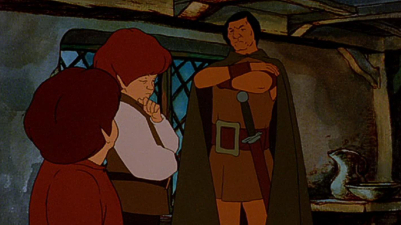
Each film seemed more erratic in nature and poorly structured than the last, and with a production time of less than a year for most, ended up being quite laborious for audiences to sit through. In the midst of Bakshi’s 1970s output came Wizards (1977), another film that pushed through a personal message, and one that came with a longer lead time of two years and laid on some sci-fi mythology to draw in larger crowds than usual (perhaps a command from 20th Century Fox, who were picking up the tab). Although Bakshi’s intention was to create a film that would appeal more to kids than his previous works, Wizards itself was not entirely free of the traits in his earlier works.
Certainly there were clear touches of Bakshi’s trademarks in the film: scantily clad women and falling back on rotoscoping for the more epic scenes do reveal a shortcoming in technical abilities. However, it’s also clear that he learned from these mistakes and, given the chance to make another similar film in The Lord Of The Rings, he was able to refine the technique to at least “sit” with the more traditionally animated characters, sometimes in the same frame. The cartoony animation of Fritz, which peppered and looked out of place in Wizards, thankfully doesn’t find a home in Bakshi’s vision of Tolkien’s Middle Earth, and not having seen Rings for a very long time, I was honestly taken aback at how well the primary characters, not all of them rotoscoped, moved fluidly.

Indeed, there is much in the first half of The Lord Of The Rings that beats anything in the more mundane moments of Disney of the time, and while some may think that this might not be saying much, let me put it another way: the true animation in Bakshi’s Rings often outclasses the work from any other studio’s animation of the time, from the punk grunge of Heavy Metal to the naturalistic approach of Watership Down. That’s when it’s not relying too much on the rotoscoping which, as better as it is here than in Bakshi’s previous efforts, does keep bringing attention to itself with its solarized process look, taking the live-action and creating a flat painted style that isn’t quite real and isn’t quite animation either.

Here the rotoscoping takes on the task of conveying size and spectacle – something that didn’t even really stand up back then, let alone against today’s epic CGI battles. But it’s not as intrusive and obvious as I remembered, and this at least looks to have been shot specifically for this Lord Of The Rings and applied to appropriate sequences, as opposed to the blatant, only half-disguised live-action footage culled from various stock footage libraries and battle films for Wizards, in which the movie Zulu is most obviously lifted from, the multiple spears and shields the army holds being a give away, and one wonders how Bakshi even got permission for this, or do they even know!?
But in Rings, Bakshi’s new method of shooting live-action for intended characters with a process that contrasts the footage and matches it better to the rest of the animation than he has done before. I wouldn’t go as far as calling it “seamless”, and one still can’t quite call it “animation”. This isn’t also to say that it isn’t as plentiful and a momentary distraction from the otherwise traditionally animated characters, but it does provide a valid way for Bakshi to show huge battle scenes on a fraction of Jackson’s budgets, and actually results in an imaginative approach that contains moments of surprisingly smooth imagery, and a melding of techniques that brings the audiences’ own imaginations into play. Even if it’s not always successful, some may find themselves wondering how certain shots were achieved.
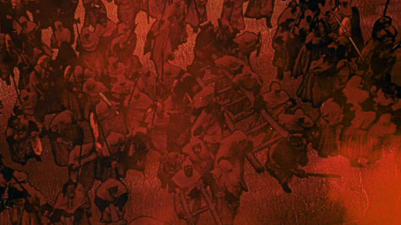
That the director had a solid story as a source is also a big plus, though it’s also this somewhat unwieldy plot that Bakshi has trouble with: famously, this greatly truncated film – even at two hours and thirteen minutes, a terrific length in animation terms – only deals with the first half of Tolkien’s story, up until the battle of Helm’s Deep, and was initially released with the subtitle of “Part One” in theaters and on home video (my original VHS marks this distinction). However, the film was critically blasted and, despite a moderately good income, the projected “Part Two” never materialized, save for a much later children’s television adaptation of Return Of The King, told in about 90 minutes by the Rankin-Bass team; this was something else Jackson was mindful of when he launched his back-to-back filmed trilogy.
It’s unfortunate that Bakshi should be criticized so much for a film that does actually work on many levels and has only had the misfortune not to find an audience initially, becoming subsequently eclipsed by an almost all-encompassing version that had a much more luxurious budget and more comfortable running time in order to tell the multi-textured story. Okay, there are many instances where those who can’t stand Bakshi’s work can point a finger and deride the achievement. It’s true that the script doesn’t always work, and that character names have been switched in some scenes but revert to their original names in others, making for some confusing viewing even to those who have read the books and supposedly know what’s going on!
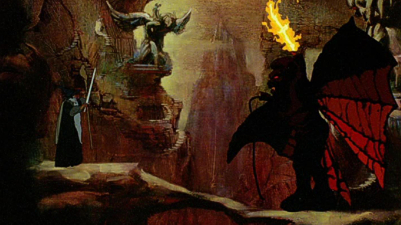
But taking Bakshi’s previous films into consideration, there’s also so much here that is right, from the animation of Frodo and the other Hobbits, handled with a delicate sensitivity, and the various designs of the other characters, all clearly either an influence on Jackson, or basically so well defined by Tolkien that anyone would have come up with the same creative choices. The design for Strider, when we first meet him, may be a bit “medieval animation 101”, but working for the character is John Hurt’s masterful voice reading, possessing the character but with inflections different enough not to have him instantly recognizable as Alien’s Kane, Hazel in Watership Down, or the twisted Horned King of The Black Cauldron.
There are other standouts in the vocals too, including Christopher Guard’s Frodo, Michael Scholes’ Sam Gamgee, and Peter Woodthorpe’s Gollum, all as close to Elijah Wood, Sean Astin and Andy Serkis’ respective portrayals of those characters in the later trilogy. Most foreshadowing of all is their designs, with Frodo almost retrospectively modelled on Wood as to be creepy in some scenes. The rest of the soundtrack is pretty decent too: Leonard Rosenman’s musical score may be a bit heavy handed, but at least we don’t get the disco-jazz and electronic synth so out of place in Wizards, and likewise with the effects spots, a mixture of traditional toon crashes and thwacks in the earlier film, but reigned here for more expressive and realistic sound here.
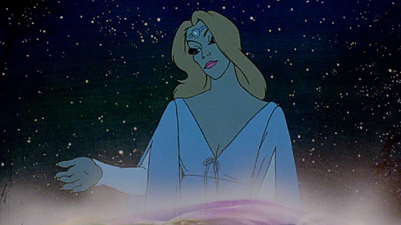
Certainly, if there’s any film in Bakshi’s canon that most closely resembles the Disney mould that he was so intent in breaking away from, it’s The Lord Of The Rings, with a surprising amount of those conventions in place. Like Wizards, Rings opens with a storybook-like recap of the events that lead up to where the story proper begins, though unlike before, these sections don’t feel overlong or packed with too much backstory and detail. However, it’s after these scenes that the movie kicks into high gear, as if Bakshi is suddenly aware that he only has two hours left to tell the whole thing. Everything is paced on fast forward, and I was surprised again (after Wizards) to find the editing was again under the supervision of Don Ernst, a long-time Bakshi collaborator who has since moved over to “the other side” to produce Disney’s Aladdin, Fantasia/2000 and Destino.

With the rush underway, characters begin to do and say things without much grounding to them, especially if you haven’t read the books or seen the later films, a pre-requisite before this viewing and a big reason as to those new to the tale in the 1970s ultimately couldn’t follow what was going on. It’s a surprise to see The Last Unicorn writer Peter S. Beagle in the credits as one of the screenplay’s adaptors, and one has to wonder if a longer script existed only to be chopped down during production. Gandalf sets Frodo off on his quest without much reasoning, and the burden on Sam and his eventual importance is lost in a character painted as a simple clownish foil for the ring-bearing Hobbit. But then amongst the pace, Bakshi will suddenly stop for a moment of slow-motion running (there’s a lot of slow-motion running) or a bizarre shot where the actor used as reference for Aragorn trips over, only to be running alongside the hair-commercial designed Legolas in the next frame. It’s as if Jackson saw the film and used it as a blueprint for the directions in where not to be headed (such as making Treebeard look like a Hanna-Barbera villain from Scooby-Doo).
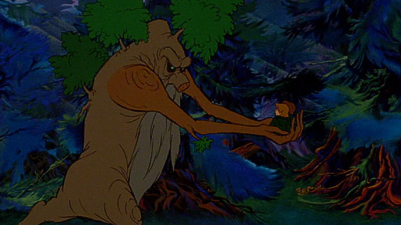
Other characters don’t make their mark as they do in Jackson’s films either: Gimli (the not-so dwarf, given the human actor used as reference!), Legolas (Anthony Daniels, C-3P0 himself) and Saruman – here sometimes referred to as Aruman, not helping newbies keep up – are painfully thin on personality, not helped by their routine vocal readings. And just when one might lament a voice or two not hitting their mark, Bakshi introduces the Ringwraiths by way of the hooded rider closing in on the four Hobbits hiding under a tree, and the animation on the rider, all bent and crippled limbs walking with an unearthly stagger, is intentionally unsettling. But then we given hoards of one-face Orcs, devoid of detail or menace, and what should be an even more terrifying emotional reaction is completely lost, just as some of the human (and therefore rotoscoped) characters fail to ever really become animated in the same way that the Hobbits successfully come alive.

Ultimately a brave stab at trying to find a mainstream audience, it seems that the subject matter may have been too great a task for the director, even at arguably the most prolific point in his career. It did attract families, but the legions of Tolkien fans that made Jackson’s films a roaring success were put off by the thought of a “cartoon” and stayed away in droves, not helping the film’s box office fortunes and eventual legacy. But despite their shortcomings, it’s Wizards, The Lord Of The Rings and the director’s next film, Fire And Ice, for which Bakshi seems most remembered, their “far off land” settings certainly helping place them more in the animated world than his sometimes laborious “real world” features.
After the failure of Fire And Ice in 1983, Bakshi’s career stalled until he was offered a return to television to revive the Mighty Mouse character for a new series (ironically it was at the original Mighty Mouse’s home, TerryToons, at which Bakshi had gotten his professional start). The New Adventures Of Mighty Mouse remains a highlight in an otherwise frustrating career, and it can arguably be reasoned that this was the show that ushered in today’s zippy and warped television animation writing and style. Since then, the director’s only big screen work has been the chaotic Cool World, a train-wreck of a film best left forgotten.

It would be all too easy to make a flippant comment and suggest (again) that we do the same with this Lord Of The Rings too. What good is half a story anyway, right? What if you do end up becoming engrossed, only for the inevitable fade out and the sudden realisation of “that’s all, folks!” bringing you back down to Earth with a thud? Yes, there is a feeling of anticipation that there should be more to come, but that it never will, at least in this form, but it’s taking the simple way out to add another level of complaint against a film that, whatever its shortcomings, makes its mark and tries to do something different with the medium. Not at all always successful in these aims, Ralph Bakshi’s The Lord Of The Rings is still a worthy curio, both a pointer to where Jackson discovered which pitfalls to stay clear of – and undoubtedly picked up some of his visual cues.

Is This Thing Loaded?
Apart from the shockingly decent audio and video, the disc also surprises in a limited number of additions that help to shade new light on Bakshi’s achievement. I’d have loved to hear a commentary from the man himself, as he did for Wizards, but in lieu of this there’s an all-new thirty minute interview documentary, Forging Through The Darkness: The Ralph Bakshi Vision For The Lord Of The Rings in 16:9 anamorphic standard definition. On the Wizards DVD, Bakshi clearly states that it would be the only time he would talk publicly about one of his films, marking it out as his favorite and an intention to break away from the profanity of his earlier, adult films. The same can be said for Rings, and Bakshi seems more at ease speaking about himself and his career, especially since the publication of the book retrospective Unfiltered.
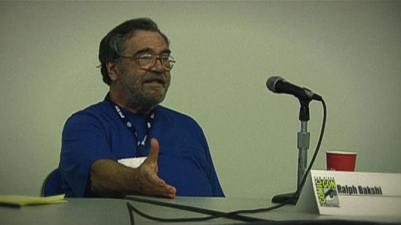
It was a pleasure to see the man in person at the Comic-Con gathering in 2008, where he was promoting Unfiltered, and a pleasant surprise to find footage from the Q&A session some of the writers from this website attended compiled in this new piece. Going on how long Bakshi spoke at the convention, there must have been a lot of material to wade through, but some choice soundbites have been chosen to highlight some of Ralph’s sometimes contradictory philosophies. The rest of the featurette concerns itself more with Bakshi’s career pre-Rings rather than illustrating the promised vision for the film itself, but it’s always interesting stuff, there’s a little less of the constant Disney-bashing that often permeates Ralph’s remarks (though it’s still there, from himself and other contributors), and he remains sprightly and outspoken even in his grand old age.
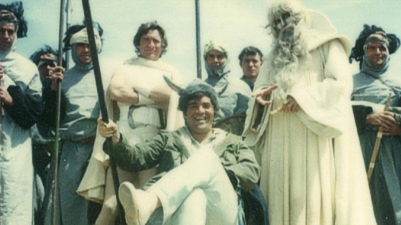
As with the Wizards DVD interview (and later supplements for Fire And Ice), this half hour almost plays as supplemental material for all of Bakshi’s films on DVD, covering his life from his New York upbringing and career from TerryToons to focusing on The Lord Of The Rings in its second half, though it’s a little heavy on promoting the Ralph as the next Walt Disney rhetoric that he never lived up to. There’s lots of archive material in this retrospective, though most disappointing is a lack of any independent voice, or even better the likes of Jackson, coming along to pay tribute and acknowledge the dept his films owe Bakshi’s version. As usual, there’s a fair bit of griping about the industry today, though the complaint against modern animators who don’t draw their films by hand is the pot calling the kettle black considering Rings is mostly known, famously or infamously, for its use of rotoscope (as is the story of one artist being fired for not getting one Hobbit’s foot hair right, ironic given the many other artistic shortcomings that actually made it into the film).

Whatever else one may level at Bakshi, it can’t be denied that his is a truly independent voice in the world of animation, and he’s taken his own risks and created his own challenges, putting his money where his mouth is to make his own films his way. However they may have turned out – and there are genuine moments of brilliance in some of his films that prove the naysayers who suggest he’s a no-talent animation hack wrong – that’s something to be commended in any day and age. Bakshi took mainstream animation and subverted it, for good or bad, and used it again as an artistic medium, and this documentary paints the director as an artist above all else. One nit-pick in the production is the use of much Academy ratio footage that hasn’t been reformatted correctly for the 16:9 frame, meaning everyone looks short and fat back in the day, though kudos to Warners for softening a couple of examples of Bakshi’s famously risqué language on a PG-rated disc.
Sadly, that’s it for supplemental footage in this package, and it would have been great of Warners to include the original theatrical trailer, TV spots and stills gallery that made it onto Fox’s Wizards disc. There was even a very nice Blu-ray preview that was created to draw attention to this release that would have made for a nice enough substitute, but we’ll have to make do with just one additional promo spot, for Star Wars: The Clone Wars, Complete Series 1, and a generic Warner Blu-ray promo. Being one of the first titles in Warners new combo pack policy (not even noted on the sleeve save for a last minute sticker on the pack), The Lord Of The Rings comes bundled with a standard definition DVD copy which replicates the Blu-ray right down to the disc art, the only differences being the BD and DVD logos.
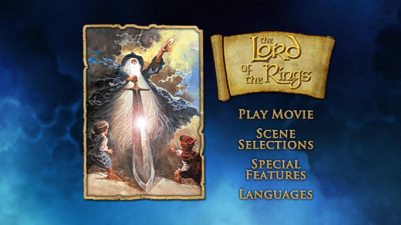
The feature presentation and documentary are naturally included, but the DVD adds a nicer main menu (with soundalike Hobbit music from Jackson’s versions) and previews for other Warner titles: naturally Jackson’s The Lord Of The Rings Trilogy on Blu-ray (largely a lacklustre package going by early word online), a terrific BD spot for The Wizard Of Oz 70th Anniversary, Saturday Morning Cartoons 1960s/70s Volume 2, Secret Saturdays Volume 1, something called Mini Ninjas, a random inclusion of the original Gremlins trailer, the Lord Of The Rings: Aragorn’s Quest video game, and Harry Potter’s Wizarding World game. A Digital Copy is also offered, although this provided by way of an insert’s redeemable code which can be used to download a Windows Media-only compatible version of the standard definition movie.
Case Study:
Recycling the striking theatrical poster art previously used on the VHS and DVD releases of The Lord Of The Rings, it’s been given an update of sorts for this Deluxe Edition via the encircling of Gandalf and Frodo within the One Ring itself, which in all honesty seems to be more modelled on Jackson’s version than this edition, or “Original Animated Classic” as the good-feeling retro marketing would have us believe. A foil embossed slipcover adds to the allure of the release, a sticker promoting the additional DVD copy inside. The back of the cover sports a couple of painted artworks for the film, one of which will only invite further comparisons with one of Jackson’s shots, while a pair of inserts promote the Digital Copy and Aragorn’s Quest game.
Ink And Paint:
As far as I can recall, this is Warners’ first major traditionally animated title to make it to Blu-ray, and that it was a fairly low budgeted attempt made in the grainy days of the 1970s didn’t raise any hopes of an image that would blow anybody away. So what a revelation that The Lord Of The Rings looks so crisp and fresh again on home video, after years of murky VHS and a previous DVD that was fine for its release almost ten years ago, but contained its fare share of print debris. Presented as before in its original theatrical ratio of 1.85:1, it’s clear from the matting that Rings was animated in the Academy format and cropped in theaters. For the most part the framing is correct, but occasionally heads wander too far to the top of the frame or get cut off, an error in the original framing, not this transfer, I should point out.

The print itself is the result of a clean-up, with most speckles removed save for cel scuff marks, and a layer of fine grain retaining the film appearance, even if a little touch of softness belies the low budget film stock originally used. It’s also worth taking note of the specially processed scenes and the optically printed rotoscoping sequences, which still look rather drab after their multiple passes, and although on the whole most fans will enjoy the brighter (though less contrast) nature of the transfer, the age of the film must be taken into consideration; something that only an out-of-reach digital restoration could ever dream of fixing. After the main titles, the color saturation of Earthy tones and muted colors finds a decent middle ground, and the 25gb disc gives just about enough room for the film to breathe without any noticeable artefacting, the dual-layered DVD also providing a better image than its previous disc release.
Scratch Tracks:
Much less satisfactory is the audio track, which seems to stem from a poor sound design back when the movie was mixed. It’s a very front-heavy track, center speaker based for much of the time with only nominal spot effects panning left or right, and only Rosenman’s score doing anything with the surrounds. It’s also very, very quiet overall, and needed a massive punch up in volume to make any kind of impact in my home theater at all (the result being that I was on volume guard all through the picture in case anything came crashing in at 0db and split my speaker system apart)! Nevertheless, this Dolby True-HD track is noticeably cleaner and more direct than what has come along before, with English, French and Spanish subs and dubs included.
Final Cut:
If you know Bakshi’s work, or have ever heard of his infamous style, then you’ll have a pretty good idea of what to expect here. I hadn’t really seen or appreciated The Lord Of The Rings in a long while, so it was more surprising to me how much I quite liked it again, though I will say that it has helped that, in the time since seeing it on video as a child and watching it again for this review, I have re-read the books and been entertained by Peter Jackson’s more comprehensive take on the story. It certainly helps fill in the pages and pages of jettisoned exposition if you know the books or the general gist of the plot from Jackson’s films.
Bakshi’s The Lord Of The Rings is far, far, far from being a perfect film, but perhaps the primary point of this review is to mark out that it’s also not as straightforwardly awful as its reputation suggests. It does have much working against it, such as the complete lack of an ending or any wrap-up that offers a glimpse of what is still to come, and the constant rotoscoping may be a real turn-off for anyone with a real animator’s eye, but the now well-known plot and characters at least make it a more accessible example of one of animation’s “name” director’s work, and it’s hard to argue against the film being an influence on Jackson’s later trilogy. For that at least, Bakshi’s Rings is worth a rental, though for real completists, this Blu-ray is likely to be the best treatment the movie will ever receive.
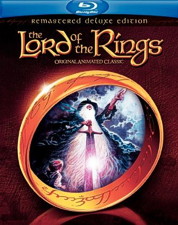 | ||
 |


